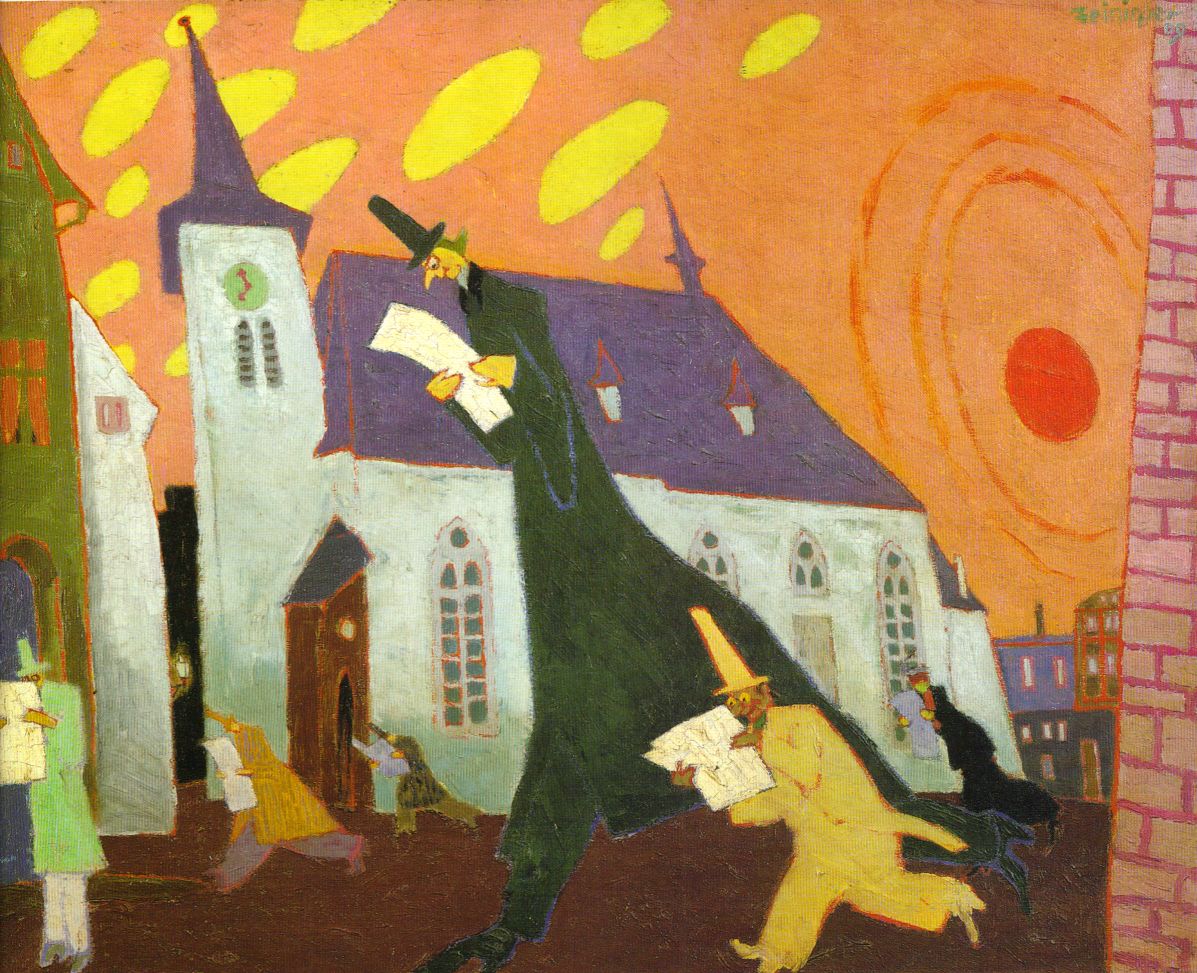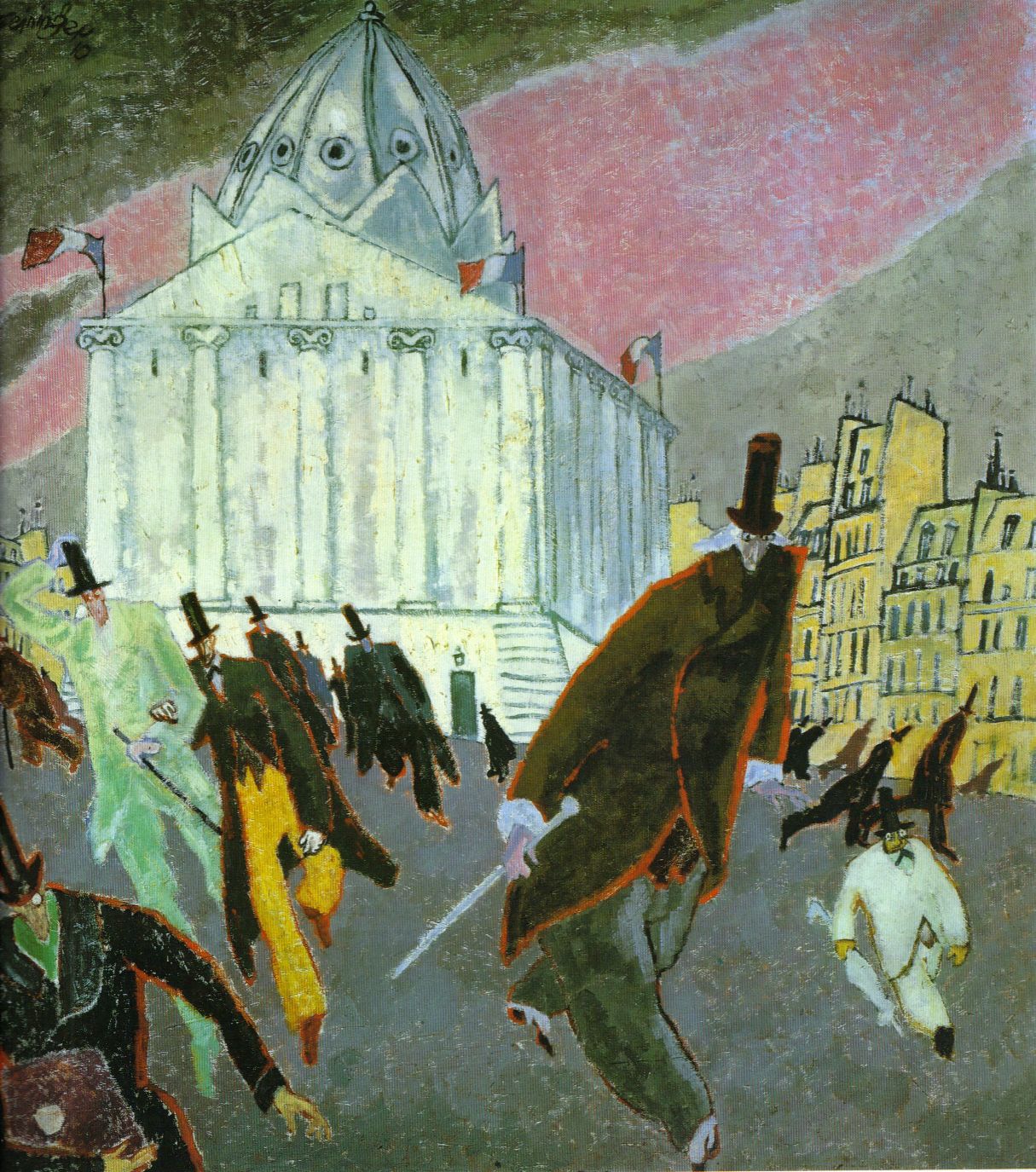Lyonel Feininger (1871–1956) was born and raised in New York. He moved at the age of sixteen to Germany, where he became one of the leading practitioners of German Expressionism and the Bauhaus. Feininger was also a member of the famous
Blue Four group of expressionists, which included
Paul Klee, Alexej von Jawlensky and
Wassily Kandinsky.
In the late 1930s the Nazi campaign against modern art forced him to flee back to New York.
Feininger was also one of the fathers of comic strips; however, his pioneering
Chicago Sunday Tribune comic strip and his figurative compositions are often tucked away in books and expositions.
In 1906, the Chicago Tribune hired him to draw cartoons for two comic strips:
The Kin-Der-Kids and
Wee Willie Winkie's World.
The Kin-Der-Kids was intended to compete with the popular
Katzenjammer Kids
comic strip. The story revolved around the adventures of the Kids, who
traveled through the world in a bathtub while avoiding their Auntie
Jim-Jam and her castor oil. The drawing style was novel and
Feininger
was one of the first cartoonists to put speech in a bubble. The contract
was canceled after nine months when Feininger refused to relocate to
America.
Lyonel Feininger (1871–1956) wurde in New York geboren, wo er auch aufwuchs. Im Alter von 16 Jahren zog er nach Deutschland, wo er einer der führenden Figuren des Deutschen Expressionismus und des Bauhauses wurde. Feininger gehörte auch zur berühmten Gruppe der
Blauen Vier, die
Paul Klee, Alexej von Jawlensky und
Wassily Kandinsky umfasste. In den späten Dreissigerjahren zwang in die Kampagne der Nazis gegen Moderne und Entartete Kunst zurück nach New York zu fliehen.
Feiniger war auch einer der Väter des Comic Strips; sein Comic Strip in der
Chicago Sunday Tribune als Pionierleistung und dessen bildliche Kompositionen wurden in Ausstellungen und Büchern oft versteckt.
1906 stellte ihn die Chicago Tribune an, zwei Comic Strips zu zeichnen:
The Kin-Der-Kids und
Wee Willie Winkie's World. The Kin-Der-Kids sollte den berühmten und populären Comic Strip
Katzenjammer Kids konkurrieren. Die Geschichte dreht sich um die Abenteuer der Kids, die in einer Badewanne durch die Welt reisen, während sie sich bemühen müssen, nicht mit ihrem Tantchen Jim-Jam
und ihrer Flasche mit Castor Öl zusammenzutreffen. Der Stil der Zeichnungen war neu und Feininger war einer der ersten, der die gesprochenen Worte in eine Sprechblase setzte. Der Vertrag mit der Zeitung wurde nach neun Monaten gekündigt, als Feininger sich weigerte nach Amerika zurückzukehren.
Publiziert 1905 in den "Lustige Blätter" No.26.
"Fertig ist die Laube" eine Art Comic mit tragischem Hintergrund. Feininger selbst ist die handelnde Person. Die Bildergeschichte spielt auf die gescheiterte Ehe von Feininger an. Er hatte kurz zuvor die verheiratete Malerin Julia Berg kennengelernt und beide hatten sich entschlossen, nicht mehr zu ihren Partnern zurückzukehren.
Published 1905 in the "Lustige Blätter" No.26.
"Fertig ist die Laube" a comic strip with a tragic background. The acting person is Feininger himself. The comic strip hints to Feininger's failed marriage. He had met the painter Julia Berg shortly before and they both had decided to return no more to their partners.
Zeitungsleser (Newspaper readers)
Men rashing from the Stock Exchange, Paris
Karneval in Arceuil
Grotesque representations of persons, nearly caricatures, are found in the early paintings of Feininger. The same elements of style appear in his comic strips, too.
The Figures of The Kin-Der-Kids
1. Picture:
Daniel Webster, the intellectual of the group, who prefers to read rather than take much notice of the action around him. Conservatively dressed, and nearly bald on top, Daniel looks quite old for his age. His dog, Sherlock Bones, accompanies him.
1. Bild
: Daniel Webster, der Intelektuelle der Gruppe. Ständig grübelt er über ein vertracktes Problem nach. Konservativ gekleidet und schon bald kahlköpfig. Eben ein Eierkopf! Sherlock, sein Dackel, begleitet ihn überall.
2. Picture:
Piemouth (aka Fatty) is all appetite. Round and eager-eyed, he thinks of nothing but food.
2. Bild:
Piemouth, der Vielfrass denkt beständig nur ans Essen. Ist Daniel der Kopf, so ist Piemouth der Bauch.
3. Picture:
Strenuous Teddy is the muscle to go with Daniel Webster's brains.
3. Bild:
Teddy der Tüchtige. Er ist der Muskel zu Websters Hirn.
Row above, 1.Picture:
Aunt Jim-Jam and her bottle of castor oil. She seems to be the only parental figure in the Kids's lives. Her concern for the Kids's welfare turns to annoyance as they dodge her attempts to dose them with the oil. Her cat, who has no name, accompanies her, along with
Cousin Gussie.
Obere Reihe 1. Bild:
Tantchen Jim-Jam mit ihrer Flasche gefüllt mit Castor Öl. Ihre Besorgnis für die Kids wird zu einem richtigen Ärgernis, wenn sie versuchen ihre Behandlung mit Öl zu unterlaufen. Ihre namenlose Katze begleitet sie. Der Bursche mit blauen Zylinderhut ist
Cousin Gussie.
2. Picture
: Phileas P. Pillbury with his five daughters. He has invented the famous Pillbury-pill for universal growth.
2. Bild:
Phileas P. Pillbury mit seinen fünf Töchtern. Er ist der Erfinder der berühmten Pillbury-Pille für universales Wachstum.
3.Picture:
Uncle Kin-Der, head of the family, hepays all the bills. 3. Bild: Der
Onkel Kin-der, eigentlich das Oberhaupt der Familie, aber nur auf dem Papier. Er bezahlt jedoch alle Rechnungen.
Row below, 1.Picture:
Mysterious Pete is, as you might guess, mysterious. He flies about on his own cloud ('Private Cloud, keep off' reads the sign on the cloud) and acts as a deus ex machina, moving the story along for his own unknown purposes. His dog, who is un-named, accompanies him.
Untere Reihe, 1. Bild:
Der mysteriöse Pete ist -wie leicht zu erraten ist- mysteriös. Er fliegt auf seiner eigenen Wolke umher ( Private Wolke, nicht betreten, kann man auf einer Tafel lesen). Er handelt wie ein Deus ex machina, und treibt die Geschichte zu seinen eigenen, unbekannten Zwecken vorwärts. Er wird auch von einem namenslosen Hund begleitet.
2. Picture: The famous bathtube of the family. 2.Bild: Die berühmte Familienbadewanne.
3. Picture:
Japansky is not really a character. He (It?) is a motor built in the shape of an Asian boy. He is operated by a series of controls on his back. Despite being non-sentient and without any personality, Japansky still manages to play an important part in several strips.
3. Bild:
Japansky ist kein wirklicher Charakter. Er ist ein Motor, gebaut in der Form eines asiatischen Knaben. Er funktioniert durch eine Serie von Kontrollknöpfen auf seinem Rücken. Obschon keine Person und ohne Gefühl spielt er dennoch eine wichtige Rolle in einigen Teilen des Strips.
Feininger stellt die Mitspieler der Kin-Der-Kids vor.
Die Reise geht los!





























































